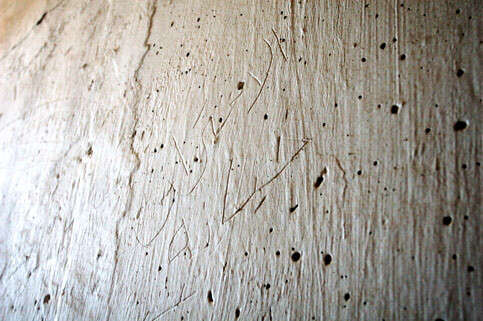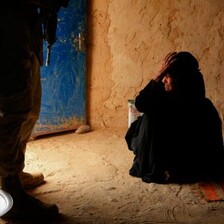The Electronic Intifada 4 May 2008

The event that went ahead: out of the week-long series of planned events commemorating the Nakba, all but one was canceled due to pressure by Egyptian authorities. (Jesse McClellend)
Egyptian security covertly organized for the cancellation of a week-long series of cultural events to commemorate the 60th anniversary of the Nakba, or the forced expulsion of Palestinians from their homeland by Zionist forces in 1947-48. The events were planned by the Habitat International Coalition-affiliated Housing and Land Rights Network (HLRN), alongside a number of Egyptian organizations. HLRN is a human rights organization which focuses primarily on advocacy for the right to housing and land. The events, according to organizers and planned participants, were set to bring the Palestinian cause closer to Egyptian youth, to raise awareness on the centrality of the Nakba to their own lives, and to mobilize them to take action individually as well as collectively.
“We had chosen to commemorate the Nakba by holding cultural events because we wanted the message to be accessible to as many people as possible, in particular youth. We also felt culture conveys a variety of different political messages at once with greater strength than other forms of action,” said HLRN Global Program Officer Angie Balata.
In addition, given the atmosphere of political repression in a country under emergency law since 1981, it was believed that a series of cultural events would not plausibly attract negative security attention and that therefore more Egyptians would be able and willing to attend.
They were proven wrong. After two months of planning, and agreement with numerous public venues, “one by one the venues started to pull out,” said Balata. Shortly before the events were set to begin, within the space of 48 hours and seemingly inexplicably, all but one venue had retracted on their willingness to host events.
There has been no direct proof of the state’s intervention. Indeed, it is unknown which branch or branches of security advised public venues to pull out. “Any Egyptian can tell you that security does not usually intervene directly on matters such as these,” Balata said, adding that the lack of transparency intensified organizers’ frustrations, as there was no clarity as to which branch of the state they could appeal to.
Therefore, though there was no evidence as such of the precise form or intervention, it was clear that coercion had taken place when each of the separate venues contacted HLRN to cancel their participation. Among the planned venues was the University of Cairo, the largest of the country’s public universities.
This is by no means the first time that the Egyptian authorities stifle action on Palestine. At peace with Israel since former President Anwar Sadat signed the Camp David Accords with then-Israeli Prime Minister Menachem Begin in 1978, “the Egyptian state has sided with Israel, even against its own people,” said Cairo-based Palestinian writer Abdel Qader Yassin. Sadat was later assassinated. Yassin insists that it is not the Egyptian people but rather the regime that has held a consistently anti-Palestinian stance.
“To silence the people’s natural sympathy with the Palestinian cause, a small number of journalists on the state’s payroll execute frequent public opinion campaigns to stifle Egyptians’ pro-Palestinian beliefs,” Yassin added. “As for the security forces, they are the state. They enforce and implement the state’s policy at the grassroots level.”
Ever since hundreds of thousands of Palestinian residents of Gaza breached the Egypt-Gaza border in January 2008, the state appears to have intensified its public position against Palestinians and action in solidarity with their cause. The intensification has taken on a number of forms, including the issuing of threats, retaliation against advocates for Palestinian rights, and a media campaign vilifying the Palestinians of Gaza.
Shortly after Egypt resealed the border, on 7 February 2008, Egyptian Foreign Minister Ahmed Aboul Gheit publicly threatened that anyone who tried to breach the border again “will get his leg broken.” Also in February, numerous articles appeared in the state-run media, accusing Palestinians coming into Egyptian territory while the border was open of “invading Egypt,” “threatening Egyptian sovereignty” and planning to settle permanently in the Sinai Peninsula. Such accusations went some way in turning Egyptian public opinion against Palestinian residents of Gaza, though generally and historically Egyptian solidarity on a popular level with the Palestinian cause is high.
On the face of it, this attitude has been attributed to a policy decision to undercut any sympathy with Hamas, which has roots in the Egyptian Muslim Brotherhood. Banned, the Brotherhood still constitutes the strongest opposition movement in Egypt, and faces severe state repression with frequency. On the other hand, any position but one of antipathy towards the Palestinians of Gaza — particularly in light of the January breach — would no doubt compromise the Egyptian regime’s relation to the US, on the basis of whose support it survives.
The event that went ahead
One venue, the Townhouse Gallery went ahead as scheduled and exhibited photography and film shot in the occupied West Bank and Gaza Strip. Titled Between the Walls, the exhibition ran for 10 consecutive days. Cairo-based Palestinian poet Haroun Hashim Rashid recited his work on the closing night of the exhibition, while Palestinian singer Abeer Sansour performed traditional music, ranging from more contemplative songs of pain and memory to passionate renditions of dabka popular songs.

“Al-Eatiraf Khiyana,” one of Michael Kennedy’s images documenting al-Fara’a detention center.
American University in Cairo post-graduate student and journalist Michael Kennedy was among the photographers exhibiting his work. Documenting the remains of what was once al-Fara’a detention center for minors near the West Bank city of Nablus, Kennedy tells the story of imprisonment and torture through the eyes of Raed, a man now in his forties, who was once a child prisoner. The center was opened by Israel’s then-Defense Minister Ariel Sharon in 1982, for the specific purpose of holding “youth activists” within its walls. In 1995, the detention center was turned over the Palestinian Authority. It has since been re-appropriated and turned into a youth center, hosting activities for children and summer camps. Half of the center has been kept intact however, in a bid to keep the memory of the horrors lived there by Palestinian children alive.
Raed, whose account is told in the first person in captions posted alongside each print, now works at the youth center. Indeed, his office is housed in the cell he was kept in for two months as a 14-year-old child. Accounts of Israeli torture methods stand in horrifying contrast to the silence the images convey. Several of the cells are still inscribed with a single message, scratched into the walls by the hands of child prisoners: “al-eatiraf khiyana,” which translates loosely as, to give in is betrayal.
Kennedy believes documenting the horrors of Israel’s prisons, and in particular of al-Faraa, is an integral part of documenting Palestinian memory. “Twenty-five percent of the total population of the West Bank, and 40 percent of the men, have at one time been imprisoned by Israel,” Kennedy said. More specifically, the plight of Palestinian children has continued to escalate. According to Defence for Children International-Palestine Section, more than 6,000 Palestinian children have been detained since the outbreak of the second intifada in 2000.
On the cancellation of the remainder of the series of events to commemorate the Nakba, Kennedy believes the reason why the events at the Townhouse Gallery went ahead is because it is far less conspicuous a space than many of the other public venues that initially agreed to participate. Many visitors to the Townhouse are foreigners, or are independently, in some form or another, already involved in cultural activity. “Still, I am glad that hundreds of people have had the chance to catch a glimpse of the reality of Israel’s institutionalized practice of imprisoning Palestinian children,” he said.

An image of Gaza fisherman Hussam al-Habash by Philip Rizk is part of a series documenting Palestinians living in the Gaza Strip under the Israeli siege.
Photographs by Egyptian-German journalist and student Philip Rizk illustrate scenes of daily life under Israel’s tightened siege in the Gaza Strip. Rizk, who lived in Gaza for two years and returned to the besieged territory in January 2008, was eager to bring out through his work the inseparability between the personal and the political. “The people I write about or take pictures of, many of them are my friends,” he said.
Of his ties to Gaza and the Palestinian people, he feels more at home in Gaza than he does in Egypt. “Whenever I spend time there, I enjoy my friends, I enjoy sharing the day-to-day struggle with them, though sometimes I cry myself to sleep at night,” he said. “But there is something so unique about the people’s resilience. Though every time I return conditions are worse, the people of Gaza resist and continue, regardless, laughing together, whatever happens.”
Serene Assir is a Beirut and Cairo-based independent journalist and blogger.
Related Links





